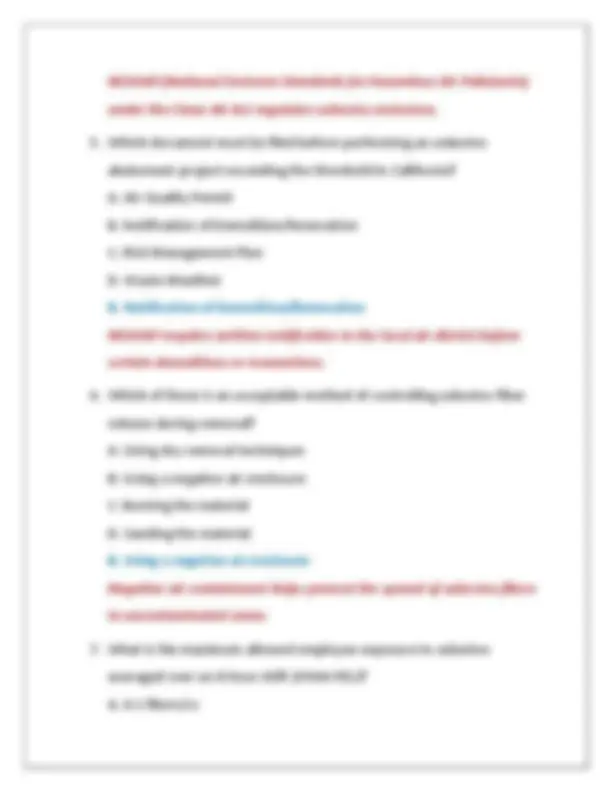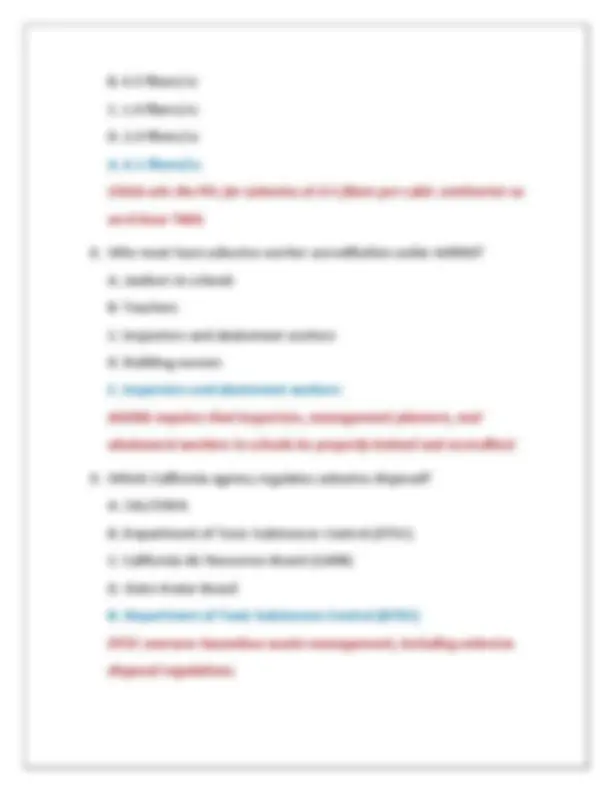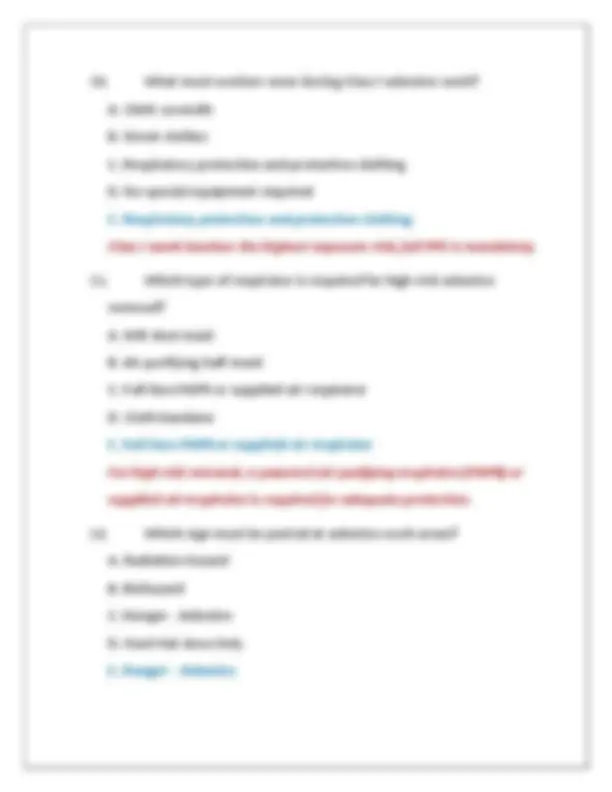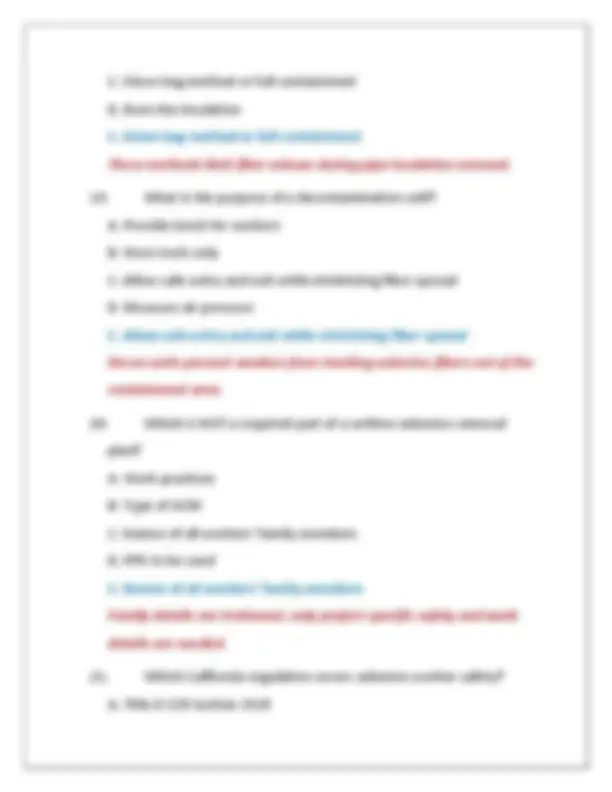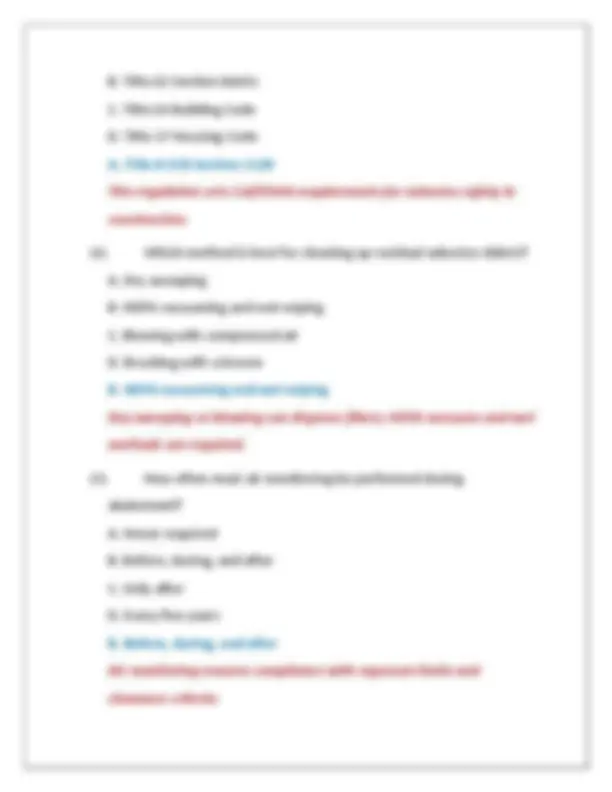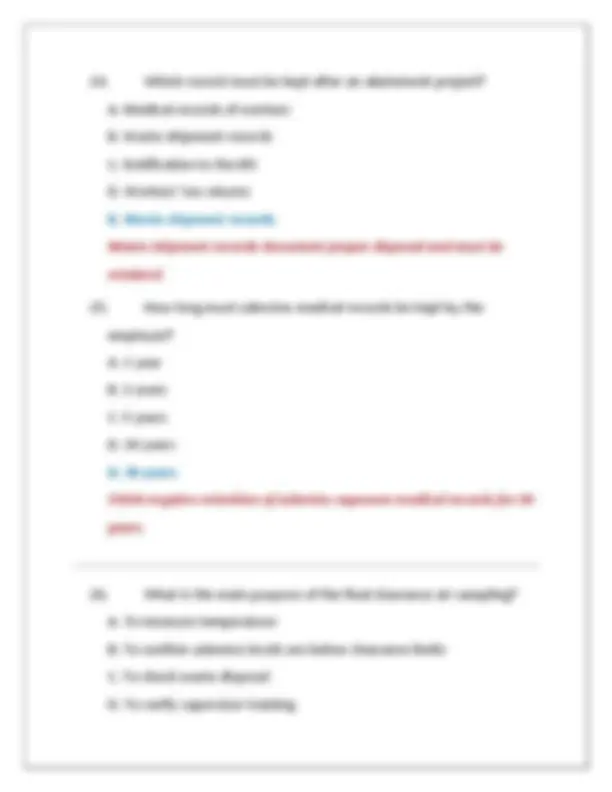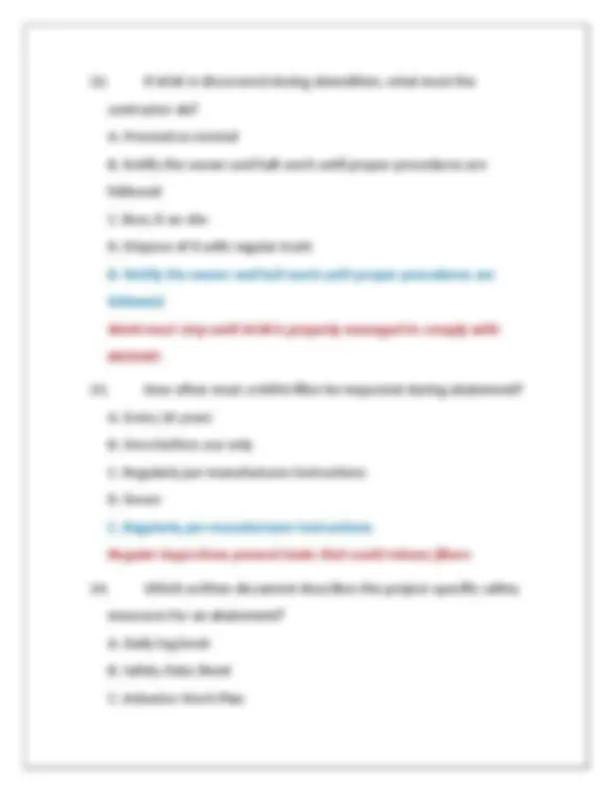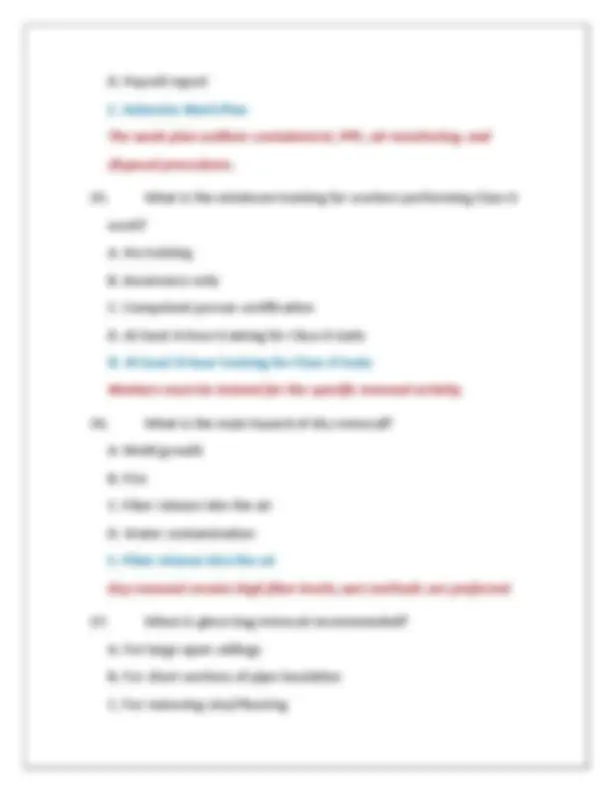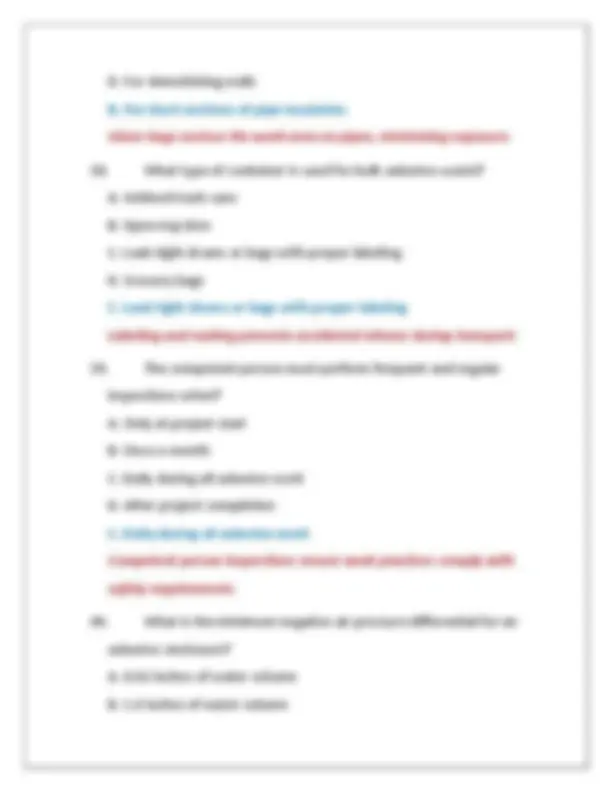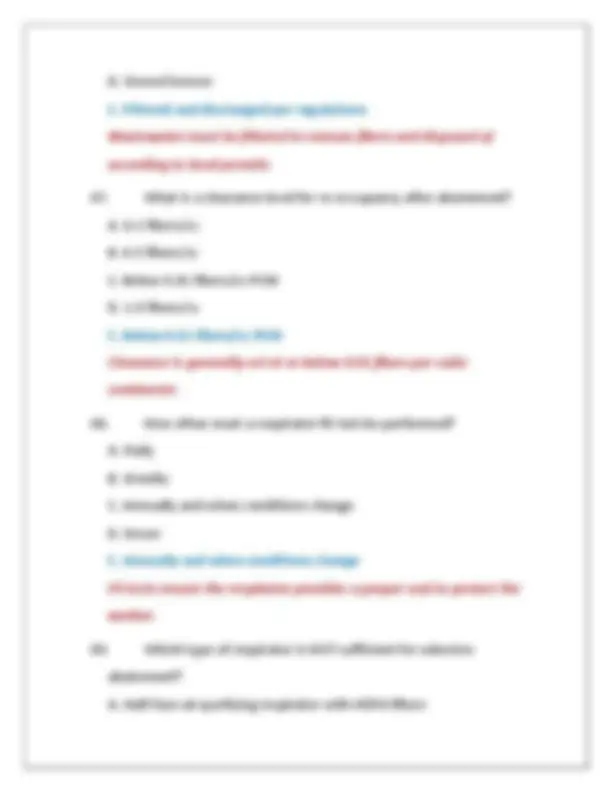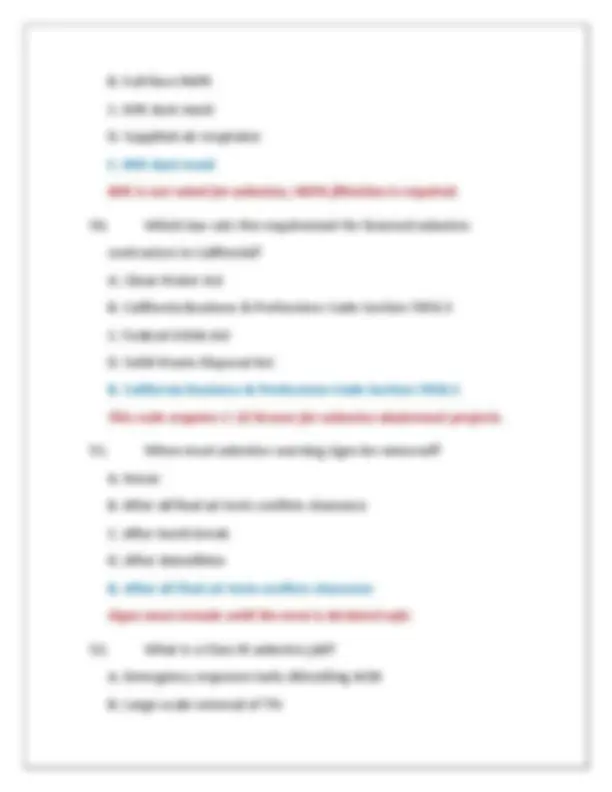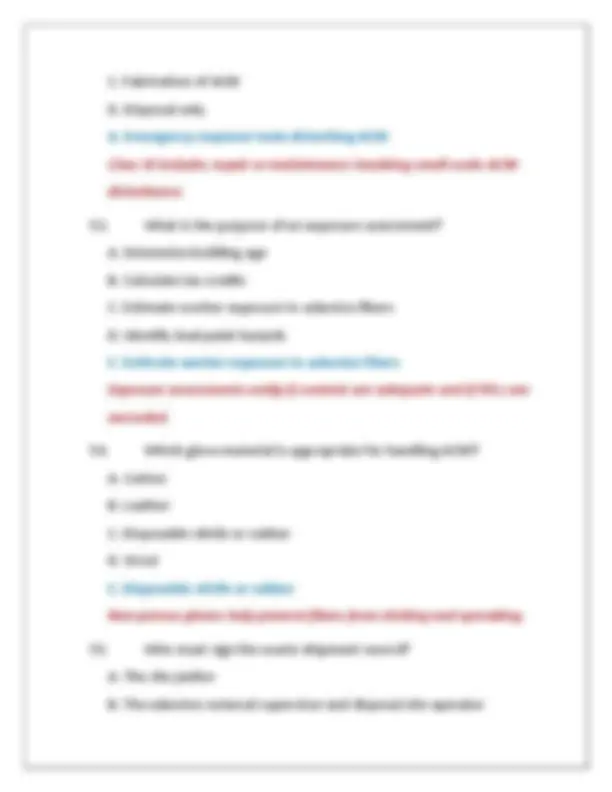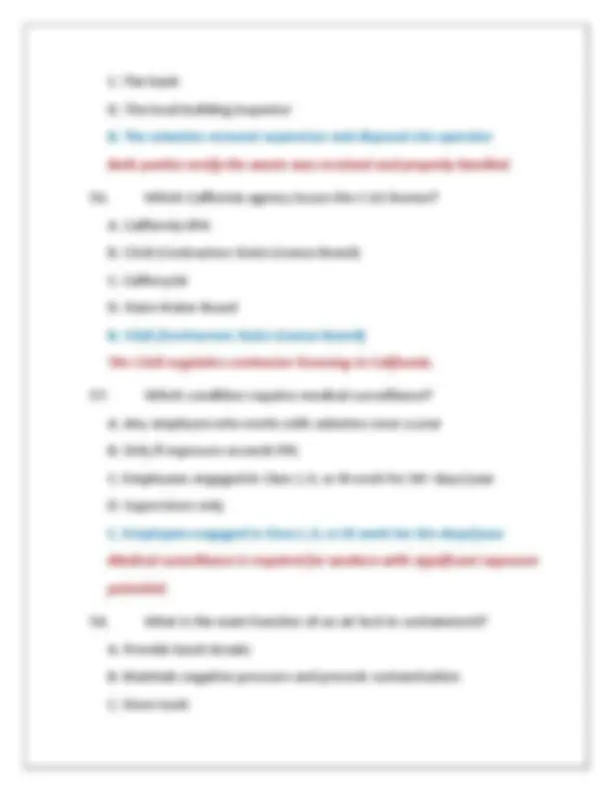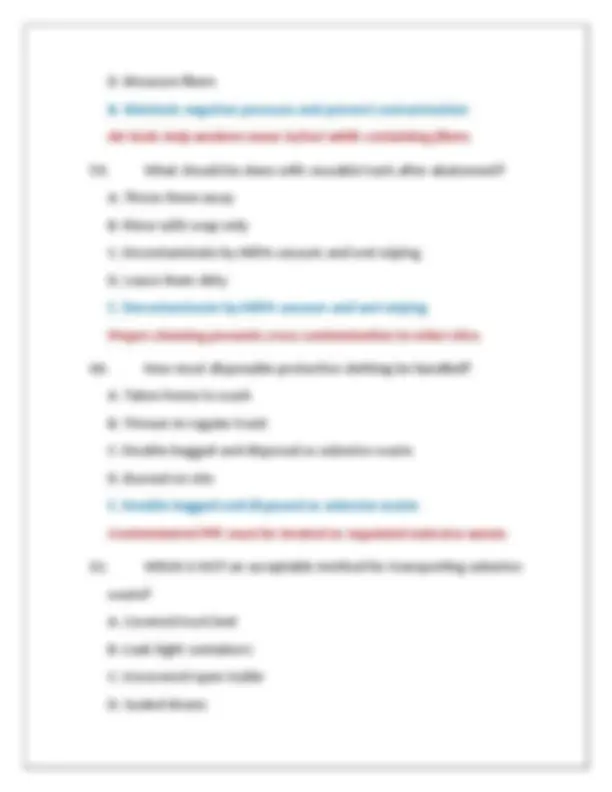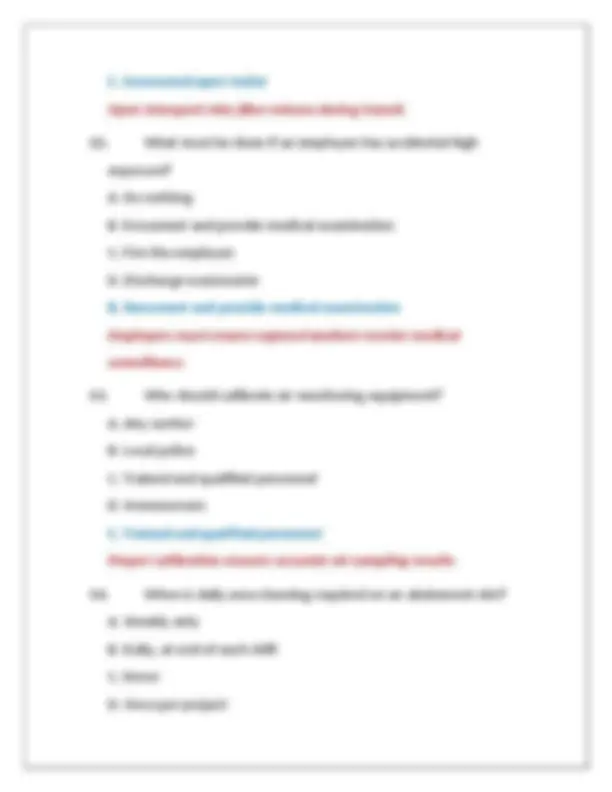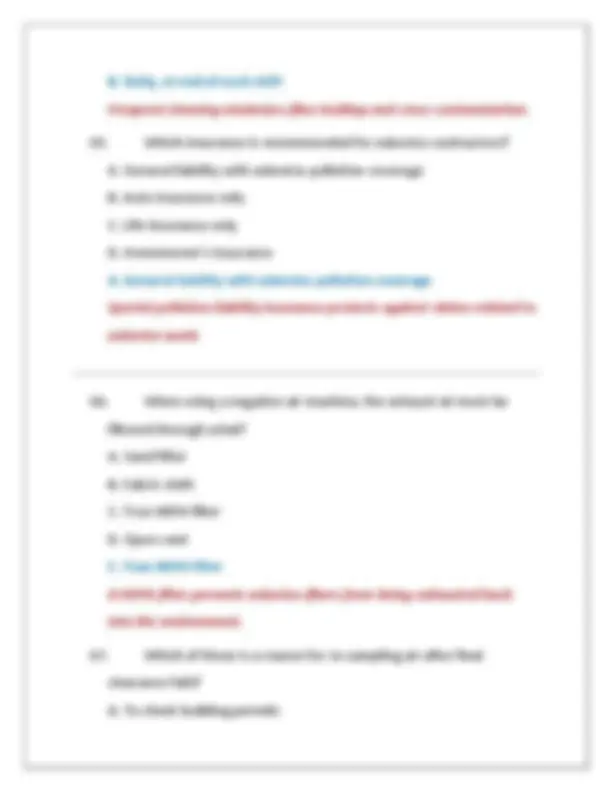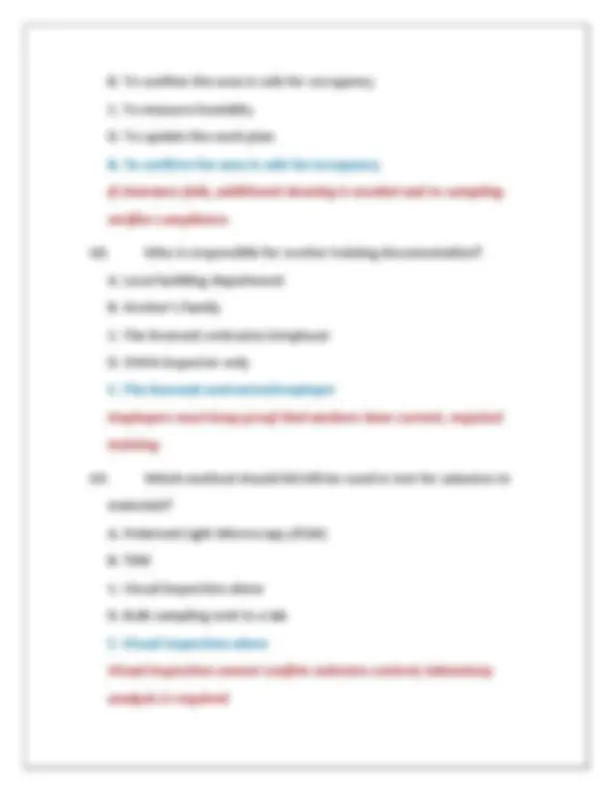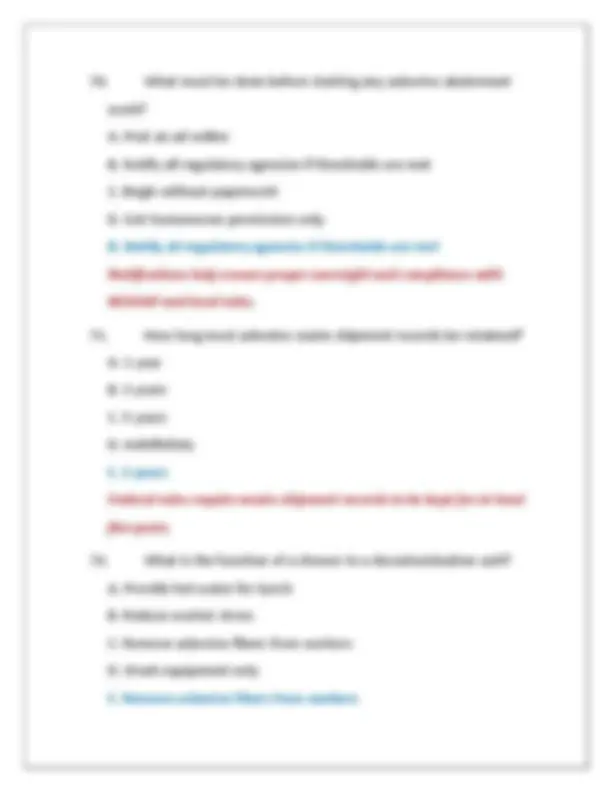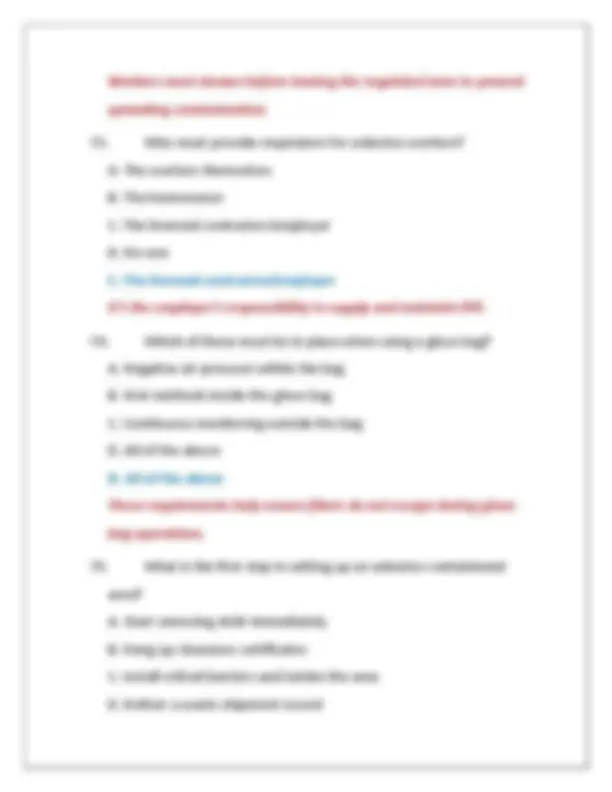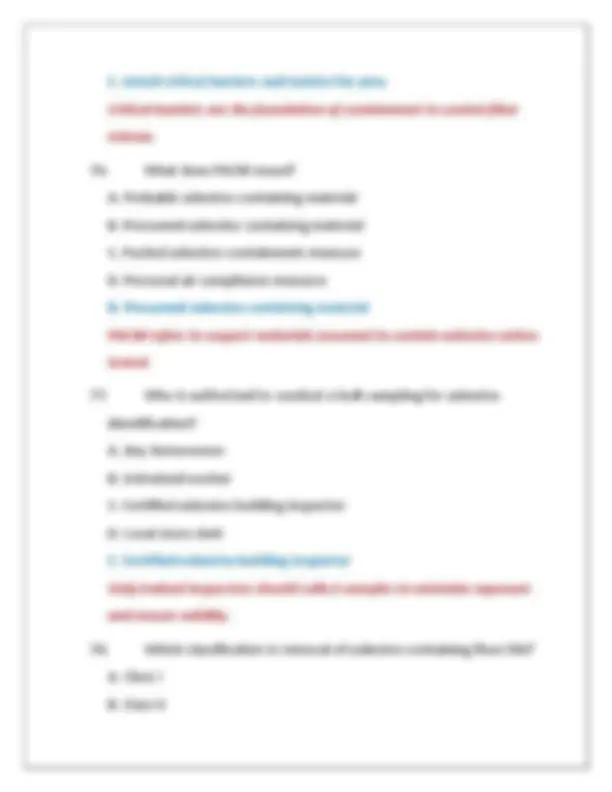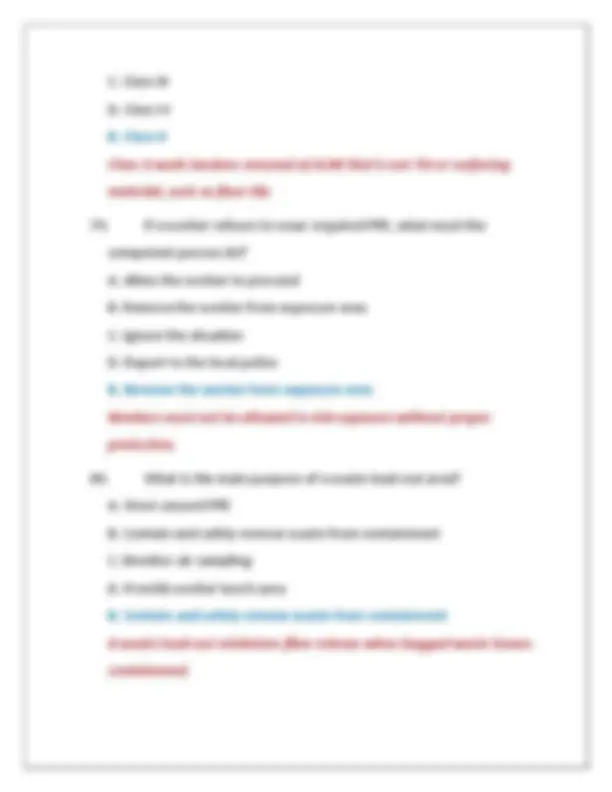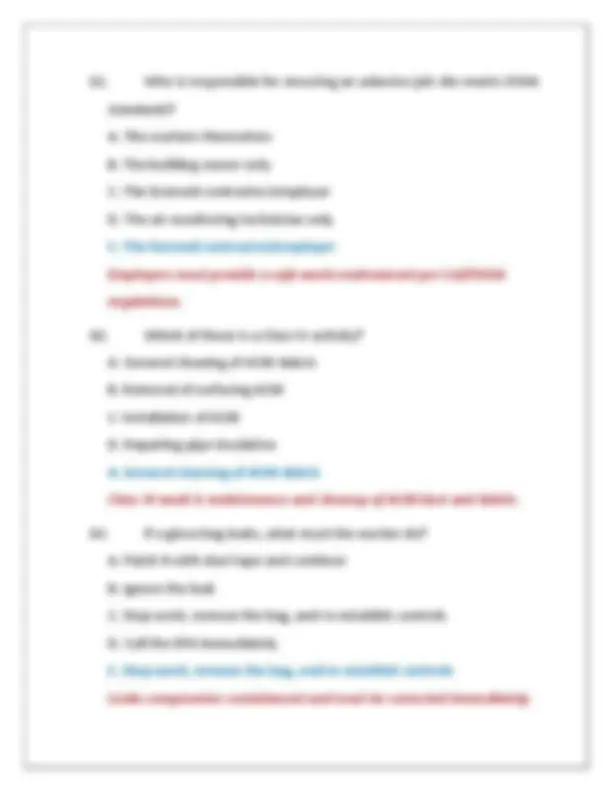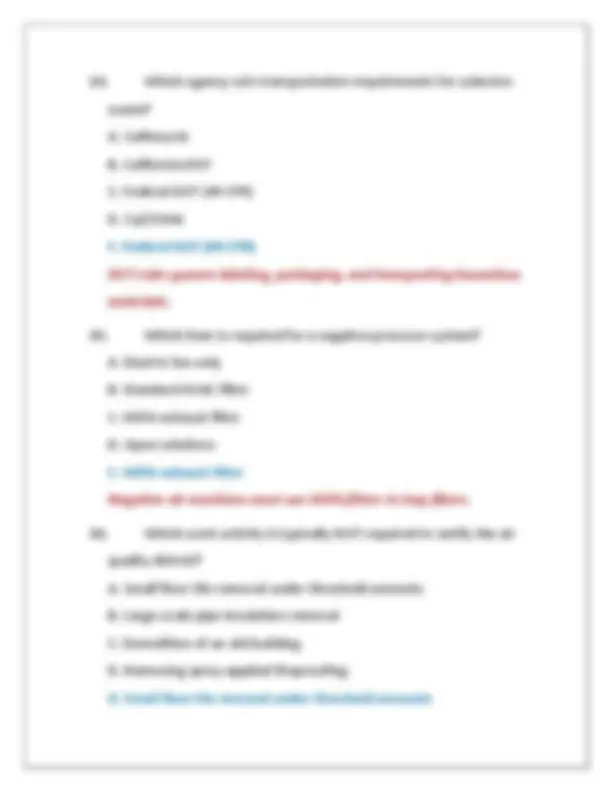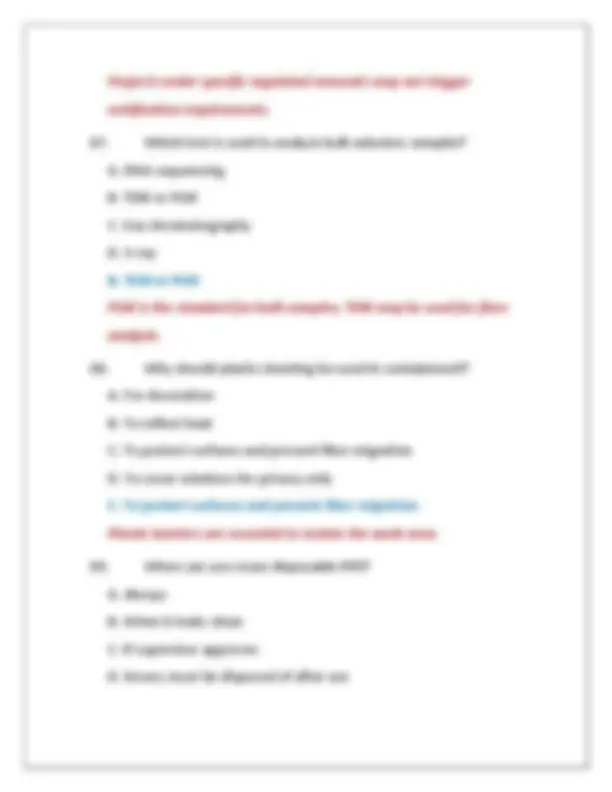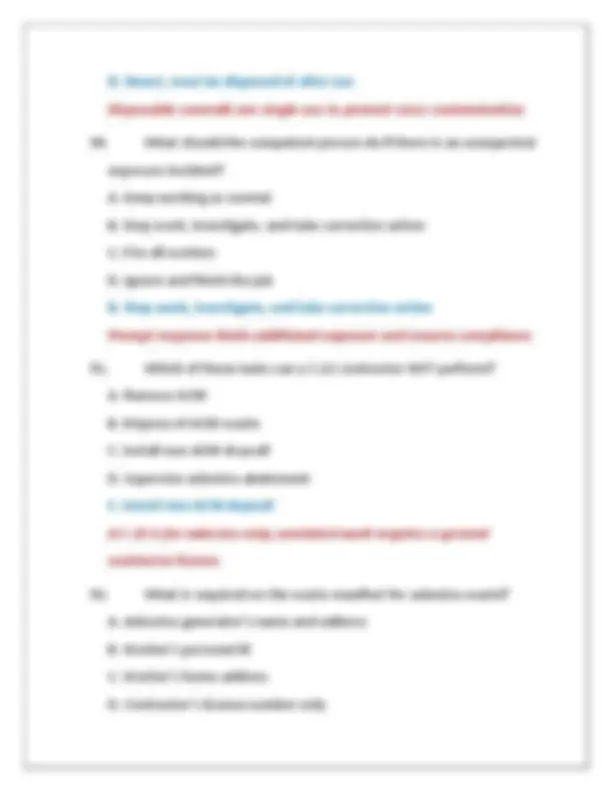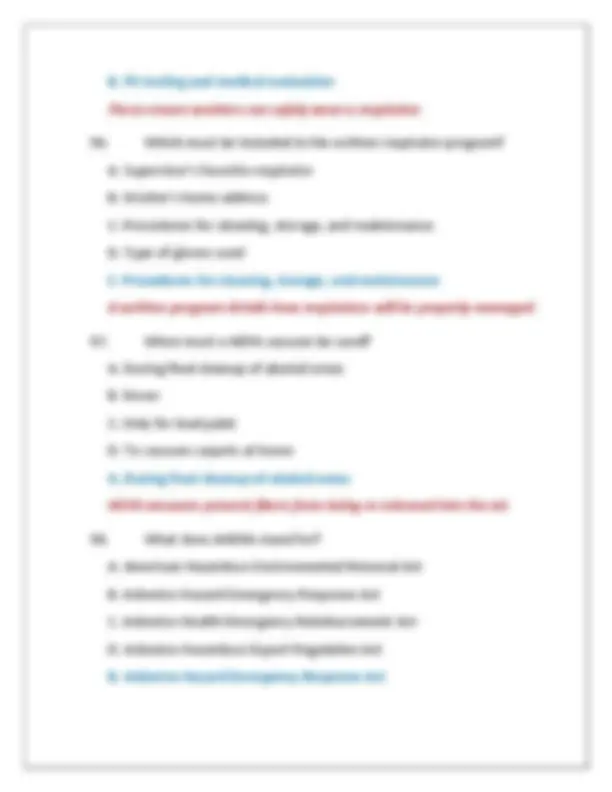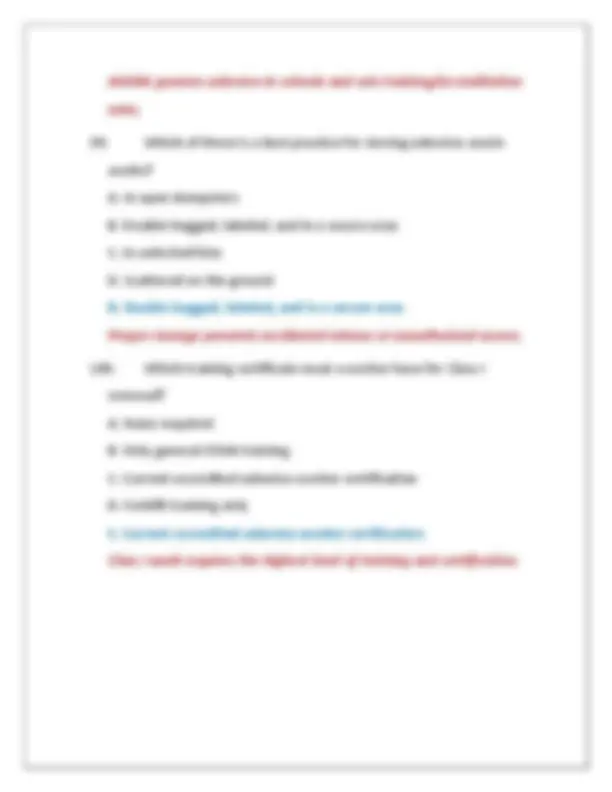Download CALIFORNIA ASBESTOS CERTIFICATION C-22 LICENSE EXAM QUESTIONS AND CORRECT ANSWERS (VERIF and more Exams Environmental Engineering in PDF only on Docsity!
CALIFORNIA ASBESTOS CERTIFICATION
C-22 LICENSE EXAM QUESTIONS AND
CORRECT ANSWERS (VERIFIED
ANSWERS) PLUS RATIONALES 2025 Q&A
| INSTANT DOWNLOAD PDF
- What does the C-22 Asbestos Certification primarily allow a contractor to do? A. Demolish any structure containing asbestos B. Install new asbestos-containing materials C. Remove or remediate asbestos-containing materials D. Design asbestos abatement plans C. Remove or remediate asbestos-containing materials Only contractors with a C-22 license may engage in asbestos abatement or removal work in California.
- Which federal agency sets the standards for asbestos exposure in the workplace? A. EPA B. OSHA C. DOT D. CalRecycle B. OSHA OSHA regulates occupational exposure to asbestos, including permissible exposure limits and work practices.
- Which of these is considered a friable asbestos-containing material? A. Vinyl asbestos tile B. Asbestos cement pipe C. Spray-applied fireproofing D. Transite panel C. Spray-applied fireproofing Friable ACM can be crumbled by hand pressure; spray-applied fireproofing is a common friable example.
- The NESHAP regulation is part of which federal law? A. Clean Water Act B. Clean Air Act C. Resource Conservation and Recovery Act D. CERCLA B. Clean Air Act
B. 0.5 fibers/cc C. 1.0 fibers/cc D. 2.0 fibers/cc A. 0.1 fibers/cc OSHA sets the PEL for asbestos at 0.1 fibers per cubic centimeter as an 8-hour TWA.
- Who must have asbestos worker accreditation under AHERA? A. Janitors in schools B. Teachers C. Inspectors and abatement workers D. Building owners C. Inspectors and abatement workers AHERA requires that inspectors, management planners, and abatement workers in schools be properly trained and accredited.
- Which California agency regulates asbestos disposal? A. CAL/OSHA B. Department of Toxic Substances Control (DTSC) C. California Air Resources Board (CARB) D. State Water Board B. Department of Toxic Substances Control (DTSC) DTSC oversees hazardous waste management, including asbestos disposal regulations.
- What must workers wear during Class I asbestos work? A. Cloth coveralls B. Street clothes C. Respiratory protection and protective clothing D. No special equipment required C. Respiratory protection and protective clothing Class I work involves the highest exposure risk; full PPE is mandatory.
- Which type of respirator is required for high-risk asbestos removal? A. N95 dust mask B. Air-purifying half-mask C. Full-face PAPR or supplied-air respirator D. Cloth bandana C. Full-face PAPR or supplied-air respirator For high-risk removal, a powered air-purifying respirator (PAPR) or supplied-air respirator is required for adequate protection.
- Which sign must be posted at asbestos work areas? A. Radiation Hazard B. Biohazard C. Danger - Asbestos D. Hard Hat Area Only C. Danger - Asbestos
D. Approved hazardous or designated asbestos waste landfill D. Approved hazardous or designated asbestos waste landfill Proper disposal is critical to prevent future exposure or environmental release.
- How must asbestos waste be packaged? A. In open containers B. Double bagged in leak-tight containers C. Mixed with general construction debris D. Stored in cardboard boxes B. Double bagged in leak-tight containers OSHA and EPA require ACM waste to be sealed in leak-tight containers and properly labeled.
- Which training is required for supervisors on asbestos jobs? A. Awareness training only B. Two hours of online training C. AHERA contractor/supervisor course D. No training needed C. AHERA contractor/supervisor course Supervisors must complete an accredited training program to perform or supervise abatement work.
- What should be done before removing ACM pipe insulation? A. Dry cut the pipe B. Remove it in small dry pieces
C. Glove bag method or full containment D. Burn the insulation C. Glove bag method or full containment These methods limit fiber release during pipe insulation removal.
- What is the purpose of a decontamination unit? A. Provide lunch for workers B. Store tools only C. Allow safe entry and exit while minimizing fiber spread D. Measure air pressure C. Allow safe entry and exit while minimizing fiber spread Decon units prevent workers from tracking asbestos fibers out of the containment area.
- Which is NOT a required part of a written asbestos removal plan? A. Work practices B. Type of ACM C. Names of all workers’ family members D. PPE to be used C. Names of all workers’ family members Family details are irrelevant; only project-specific safety and work details are needed.
- Which California regulation covers asbestos worker safety? A. Title 8 CCR Section 1529
- Which record must be kept after an abatement project? A. Medical records of workers B. Waste shipment records C. Notification to the IRS D. Workers’ tax returns B. Waste shipment records Waste shipment records document proper disposal and must be retained.
- How long must asbestos medical records be kept by the employer? A. 1 year B. 3 years C. 5 years D. 30 years D. 30 years OSHA requires retention of asbestos exposure medical records for 30 years.
- What is the main purpose of the final clearance air sampling? A. To measure temperature B. To confirm asbestos levels are below clearance limits C. To check waste disposal D. To verify supervisor training
B. To confirm asbestos levels are below clearance limits Clearance sampling ensures the area is safe for re-occupancy after abatement.
- What type of filter must be used in HEPA vacuums for asbestos cleanup? A. Standard dust filter B. Water filter C. True HEPA filter D. Charcoal filter C. True HEPA filter A true HEPA filter captures at least 99.97% of particles 0.3 microns or larger, preventing fiber release.
- Which of the following is an example of a non-friable ACM? A. Pipe insulation B. Popcorn ceiling C. Vinyl asbestos floor tile D. Loose fill attic insulation C. Vinyl asbestos floor tile Non-friable ACM is bound tightly and does not easily release fibers unless disturbed.
- Which work class is the removal of TSI and surfacing ACM? A. Class IV B. Class III
- If ACM is discovered during demolition, what must the contractor do? A. Proceed as normal B. Notify the owner and halt work until proper procedures are followed C. Bury it on site D. Dispose of it with regular trash B. Notify the owner and halt work until proper procedures are followed Work must stop until ACM is properly managed to comply with NESHAP.
- How often must a HEPA filter be inspected during abatement? A. Every 10 years B. Once before use only C. Regularly per manufacturer instructions D. Never C. Regularly per manufacturer instructions Regular inspections prevent leaks that could release fibers.
- Which written document describes the project-specific safety measures for an abatement? A. Daily log book B. Safety Data Sheet C. Asbestos Work Plan
D. Payroll report C. Asbestos Work Plan The work plan outlines containment, PPE, air monitoring, and disposal procedures.
- What is the minimum training for workers performing Class II work? A. No training B. Awareness only C. Competent person certification D. At least 8-hour training for Class II tasks D. At least 8-hour training for Class II tasks Workers must be trained for the specific removal activity.
- What is the main hazard of dry removal? A. Mold growth B. Fire C. Fiber release into the air D. Water contamination C. Fiber release into the air Dry removal creates high fiber levels; wet methods are preferred.
- When is glove bag removal recommended? A. For large open ceilings B. For short sections of pipe insulation C. For removing vinyl flooring
C. 0.5 psi D. 10 psi A. 0.02 inches of water column A minimum of - 0.02 w.c. helps contain fibers.
- Which practice is prohibited when working with ACM? A. HEPA vacuuming B. Wet methods C. Dry sweeping D. Wet wiping C. Dry sweeping Dry sweeping stirs up fibers, increasing inhalation risk.
- What must be included on asbestos waste labels? A. Project cost B. Contractor’s phone number C. Asbestos hazard warning statement D. Number of workers on site C. Asbestos hazard warning statement Labels must state “Caution Contains Asbestos Fibers – Avoid Creating Dust”.
- What should workers do if their protective clothing is damaged? A. Ignore it B. Wash it at home C. Replace it immediately
D. Patch it with tape only C. Replace it immediately Damaged PPE fails to protect the worker.
- Which test confirms asbestos fibers in air samples? A. DNA test B. PCM or TEM analysis C. Soil pH test D. Mold test B. PCM or TEM analysis Phase contrast microscopy (PCM) or transmission electron microscopy (TEM) are standard methods.
- Who must be notified if an unexpected large amount of ACM is found? A. Neighbors B. Local air quality district C. The IRS D. OSHA only B. Local air quality district Notification ensures regulatory compliance under NESHAP.
- How must asbestos-contaminated water be handled? A. Discharged to storm drains B. Reused for gardening C. Filtered and discharged per regulations
B. Full-face PAPR C. N95 dust mask D. Supplied-air respirator C. N95 dust mask N95 is not rated for asbestos; HEPA filtration is required.
- Which law sets the requirement for licensed asbestos contractors in California? A. Clean Water Act B. California Business & Professions Code Section 7058. C. Federal OSHA Act D. Solid Waste Disposal Act B. California Business & Professions Code Section 7058. This code requires C-22 license for asbestos abatement projects.
- When must asbestos warning signs be removed? A. Never B. After all final air tests confirm clearance C. After lunch break D. After demolition B. After all final air tests confirm clearance Signs must remain until the area is declared safe.
- What is a Class III asbestos job? A. Emergency response tasks disturbing ACM B. Large-scale removal of TSI
C. Fabrication of ACM D. Disposal only A. Emergency response tasks disturbing ACM Class III includes repair or maintenance involving small-scale ACM disturbance.
- What is the purpose of an exposure assessment? A. Determine building age B. Calculate tax credits C. Estimate worker exposure to asbestos fibers D. Identify lead paint hazards C. Estimate worker exposure to asbestos fibers Exposure assessments verify if controls are adequate and if PELs are exceeded.
- Which glove material is appropriate for handling ACM? A. Cotton B. Leather C. Disposable nitrile or rubber D. Wool C. Disposable nitrile or rubber Non-porous gloves help prevent fibers from sticking and spreading.
- Who must sign the waste shipment record? A. The site janitor B. The asbestos removal supervisor and disposal site operator

